Monos Expandable Carry-On Pro Review
Even with a hardside design, the Monos Expandable Carry-On Pro incorporates a separate laptop compartment so you can travel with your productivity machine.
Our Verdict
Save time. Get access to brief summaries of our reviews so you can browse and make decisions more efficiently.
Pros
- The expansion system affords you some leeway in case you bulk up on souvenirs
- It has a secondary laptop compartment despite its hardside design
- We find the carry on rolls really smoothly and quietly
Cons
- You lose packing space due to the front compartment
- Expansion system impacts carry-on compliance
- It's harder to extend and retract the telescoping handle when your gear compresses it in a fully packed main compartment
Technical Details
-
Capacity
35.5l
41.5L when expanded
-
Weight (lb)
8.6 lb (3.9 kg)
-
Dimensions
22 in x 14 in x 10 in (55.9 x 35.6 x 25.4 cm)
-
Notable Materials
Polycarbonate, Recycled Polyester, Nylon, YKK Zippers
-
Laptop Compartment Size
16"
-
Warranty Information
Full Review
How does a product turn “Pro”? Of course, the answer is arbitrary according to what the brand wants. However, you can usually point to at least one functional feature that makes it truly stand out. And in the Monos Expandable Carry-On Pro’s case, there are at least two.
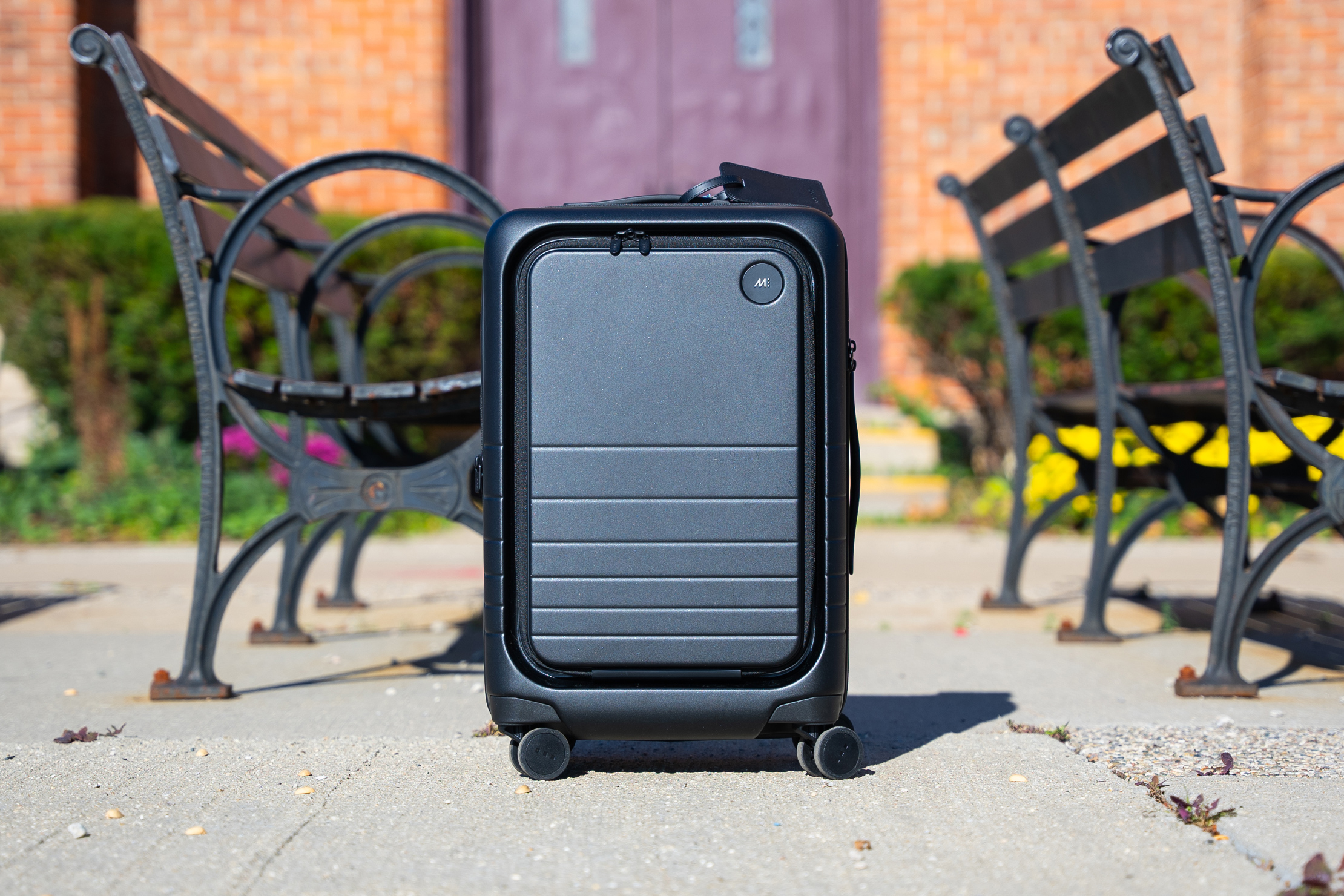
It has an expansion system and a secondary compartment for your laptop and its accessories. Those are pretty unique, especially when you consider that this is hardside luggage, which is the type you don’t usually associate with those kinds of extra features. They both sit atop a solid foundation of proven materials, smooth rolling wheels, and a telescoping handle with four height adjustments.
External Components
Materials-wise, not much stands out on the Monos Expandable Carry-On Pro. The plastic body is polycarbonate, and you get some ultra-microfiber vegan leather accents to give the entire bag a premium touch. You know what they say, “If it ain’t broke, don’t fix it,” so Monos kept things simple. That’s not to say that the build quality is flimsy or poor. A plastic body like this can take bumps and pressure quite well since it can flex and maintain its shape. You can’t say the same for metal shells, which, once dented, stay dented. On the other hand, scratches continue to be a problem for plastics. Fortunately, our sample didn’t accrue any throughout testing, though it’ll likely earn them at some point over time.
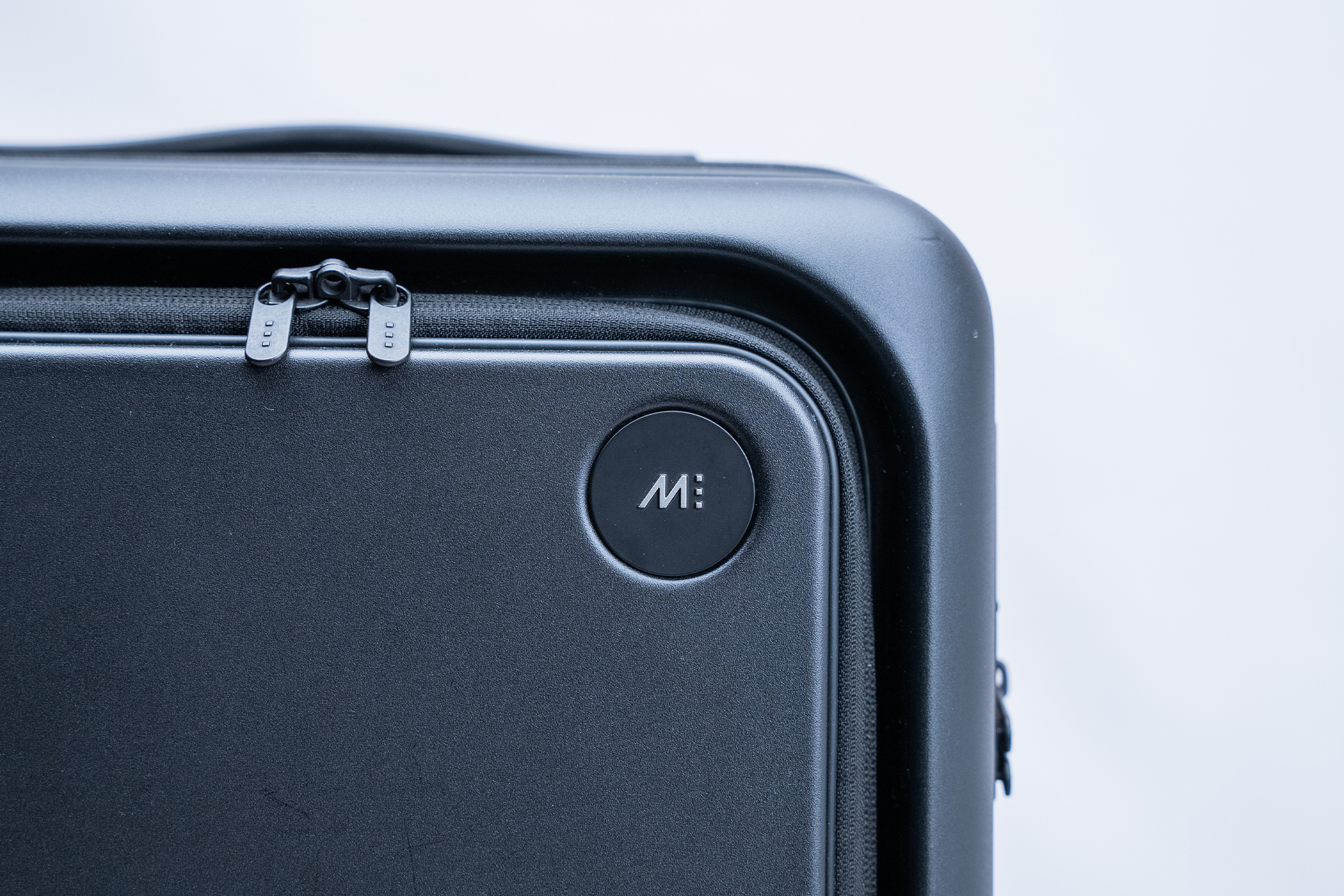
Most of the front is bordered by a continuous zipper track, making for a neat-looking island-style facade that’s very different from the usual plain-faced rollers we usually see. There are also the usual visual cues, such as ridges to break the otherwise monotonous surface, plus a neatly tucked-away logo for branding purposes. Overall, the design is pretty unique, though the functional explanation of why Monos designed it this way will have to wait until the last section of the review.
The zippers are from YKK, which is almost always short-hand for “very reliable” in the world of travel gear. The front ones need a separate TSA-approved lock, but there is a built-in lock for the main compartment’s zippers. It’s a three-digit combination lock with a slot that the TSA can use to open at their discretion (it’s what makes it a TSA-approved lock). Again, these are more or less standard features for lots of rolling luggage, and we fully expect big brands like Monos to opt for branded zippers instead of generic ones.
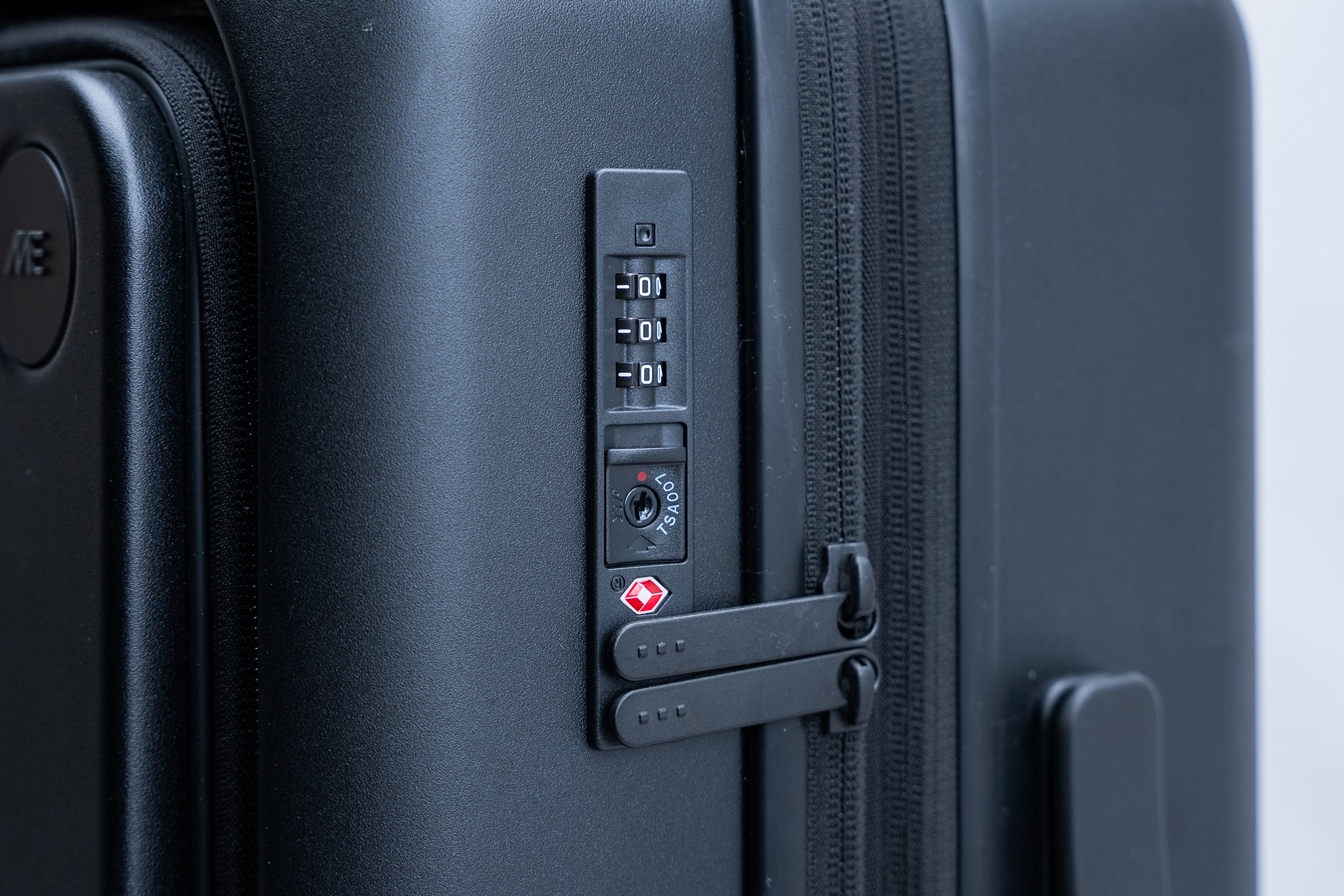
There are grab handles at the top and the right side for those times you can’t roll the bag around. Sadly, these sit quite flush against the bag, so there’s not much room to slip your hand into them. It’s fine if you have particularly slender hands, but those of a larger stature might struggle. Additionally, these handles don’t have any padding for comfort. We’re not usually very picky about that since we only use grab handles for quickly taking the bag in and out of overhead bins and car trunks. That said, we can totally see these being painfully tedious to bear if you have to hand-carry the bag up two or three flights of stairs—those who like to book elevator-less old-school hotels will relate.
At the bottom are the four sets of wheels that put the “roll” in rolling luggage. And yes, that’s “sets” because each corner has two wheels to spread out the bag’s weight. Additionally, each wheel is lined with rubber to ensure smooth rolling, even against rough surfaces. That also minimizes rattling or jittering noises when pulling the bag around, making for an overall very quiet and easy-rolling experience. That’s not really surprising to us since the other Monos luggage we’ve tested also rolls pretty smoothly.
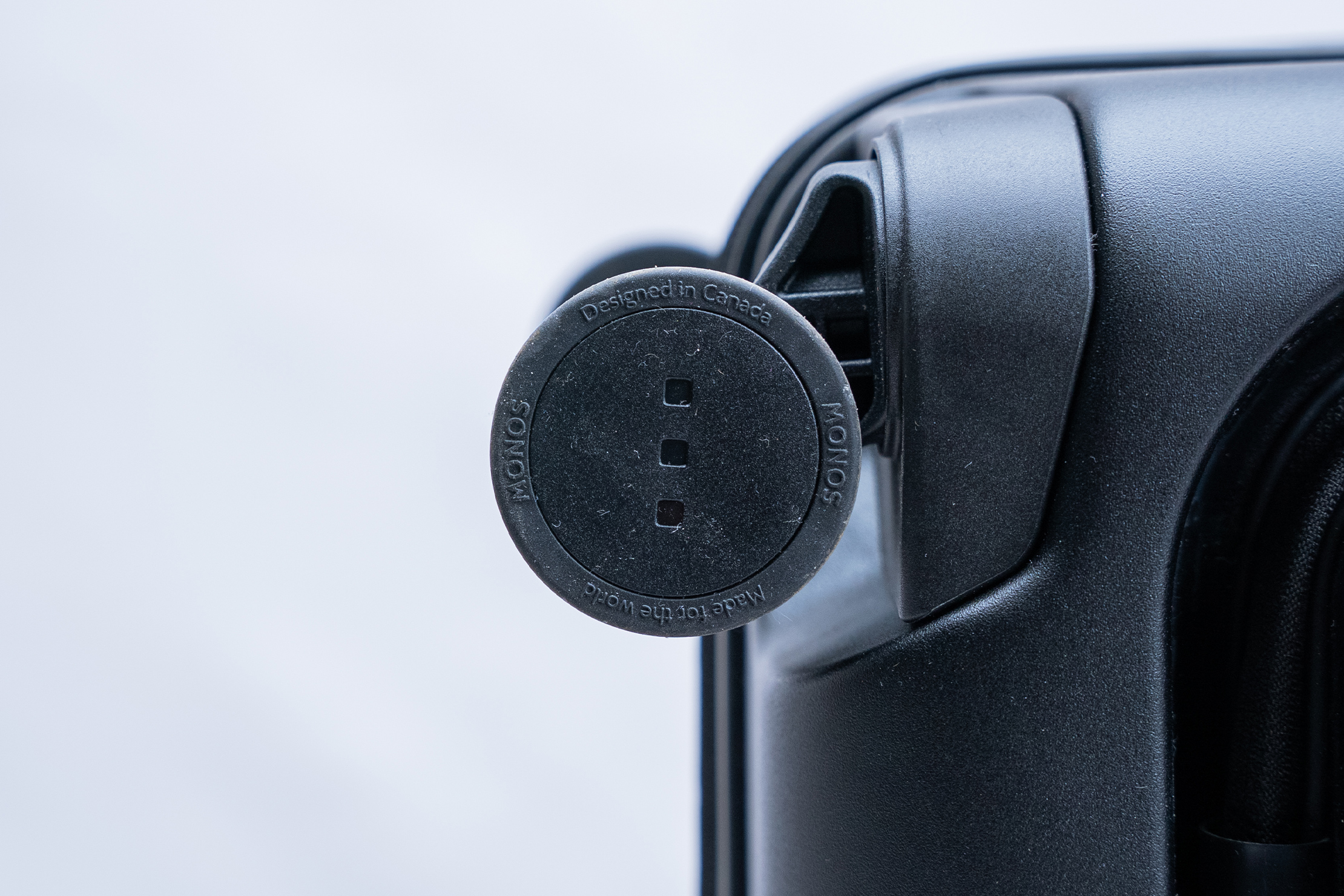
Next up is the main telescoping handle. It’s pretty slender throughout, from the shafts to the handle itself. The latter’s shape is slightly triangular, but that’s relatively ergonomic and comfortable to hold. In terms of adjustment, you get four levels to choose from, so it should be fairly easy to find an ideal one. If nothing else, that’s a generous amount based on our experience testing rolling luggage, which mostly has three or even just two positions in some cases.
Fit Notes
Indeed, having four height adjustments helped us get comfortable with this bag. We like to roll luggage beside us on all four sets of wheels, and in this mode, setting the handle to its lowest adjustment is ideal for those with shorter frames. Taller users should find one of the three higher options more than enough.
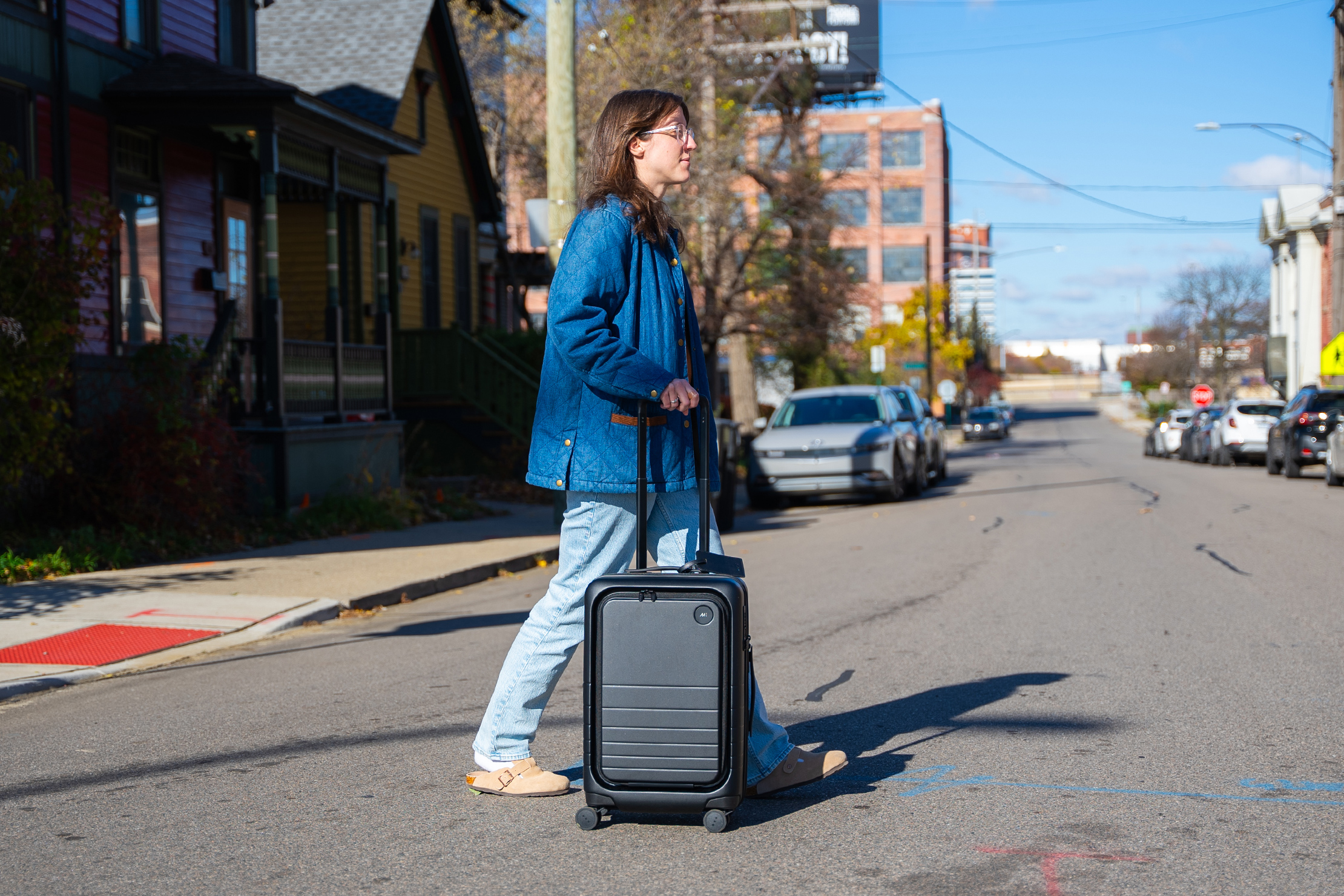
There’s nothing to report about how the wheels roll. As mentioned, the rubber lining mutes most jitters, and you’ll only really struggle if you go over pockmarked pavement or gravel. Our only real complaint is that, once the main compartment’s fully packed out, the telescoping handle’s shafts get noticeably squeezed when you try to expand or retract it. When that happens, you have to pull it a bit harder or push it in manually, as it won’t drop all the way down under its own weight when you release the lock.
Inside The Carry On Luggage
The unique-looking front starts to make more practical sense once you realize it’s a full-fledged compartment that’s suspended on the bag’s frame. It lets Monos put a secondary compartment on hardside luggage, something you’d only typically see with softside luggage since those bags’ fabric material is much easier to manipulate.
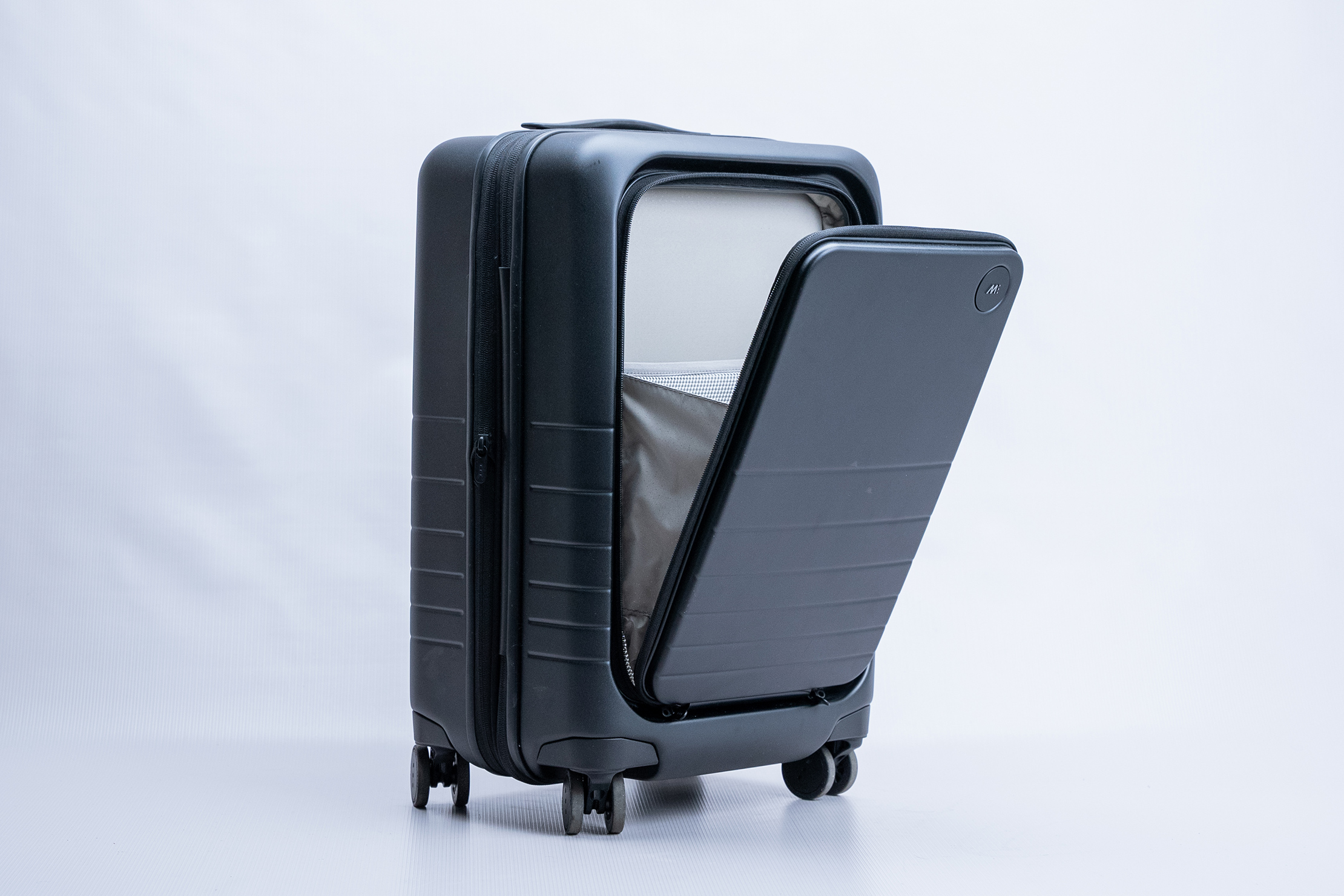
However, the zippers fall into the bordering ridge, where they may be hard to grab. See, when this compartment is sunken into the frame, the zippers also get buried into the ridge. However, once the compartment is bulging out, whether because it’s fully packed or the main compartment is pushing against it, the zippers are much easier to spot.
Once opened, you’ll find a laptop sleeve at the back that’s big enough for a 16-inch MacBook Pro, plus a zippered mesh pocket and liner pocket on the front side. In other words, this compartment’s ostensibly meant for tech, though nothing’s stopping you if you want to use it to store magazines or toiletries. As mentioned, the main compartment can cut into this compartment, but it’s also true the other way around, so just keep that in mind.
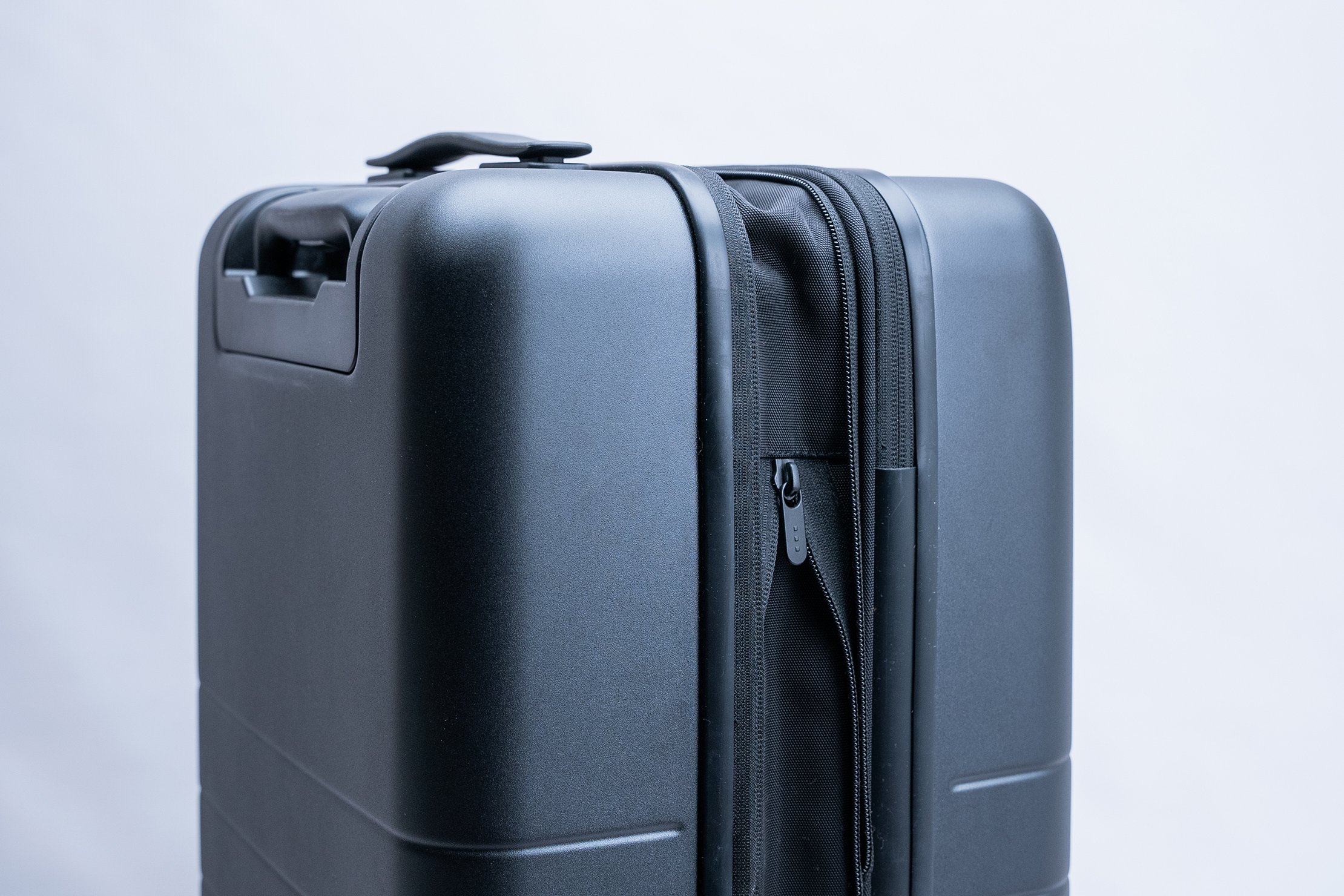
So, how does this bag’s expansion work? It’s nothing we haven’t seen before; a zipper runs parallel along the main compartment’s zippers. Undoing it releases 1.6 inches of depth, expanding the base capacity from 35.5L to 41.5L. Keep in mind that carry-on compliance is spotty at its base capacity since the dimensions are just ever-so over a lot of carrier’s restrictions (we’re talking fractions of an inch over limits). So, if you decide to use the expansion system, you’re more likely to go over those limits and get gate-checked.
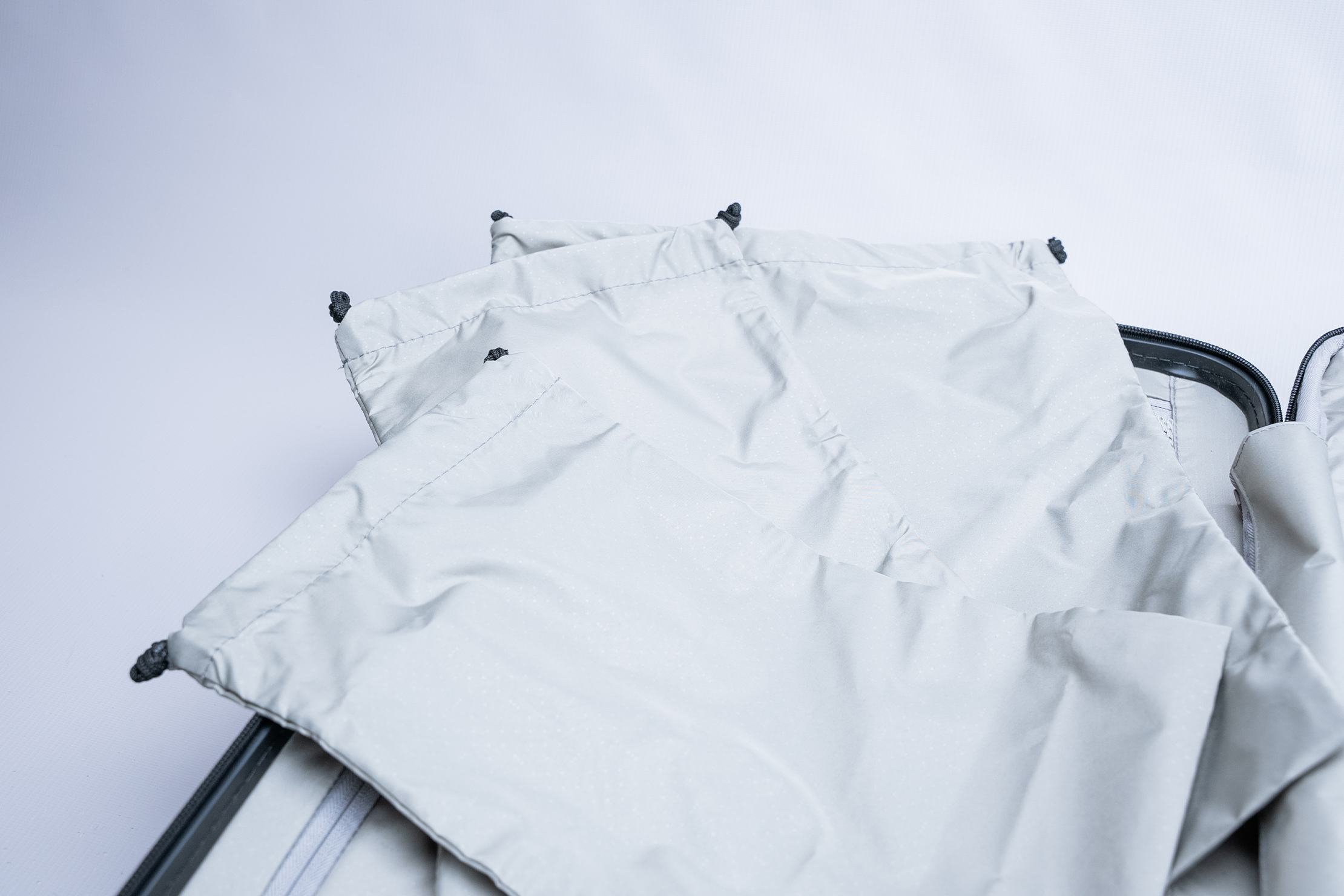
With the fancy stuff out of the way, it’s time to go over the bag’s rather conventional interior. Again, if it works, it works, and so we understand why Monos is sticking with a clamshell-style main compartment, with a big bucket space on the right and a shallower mesh-covered compartment on the left. It’s simple and straightforward while maximizing the space and organization you’d want from rolling luggage.
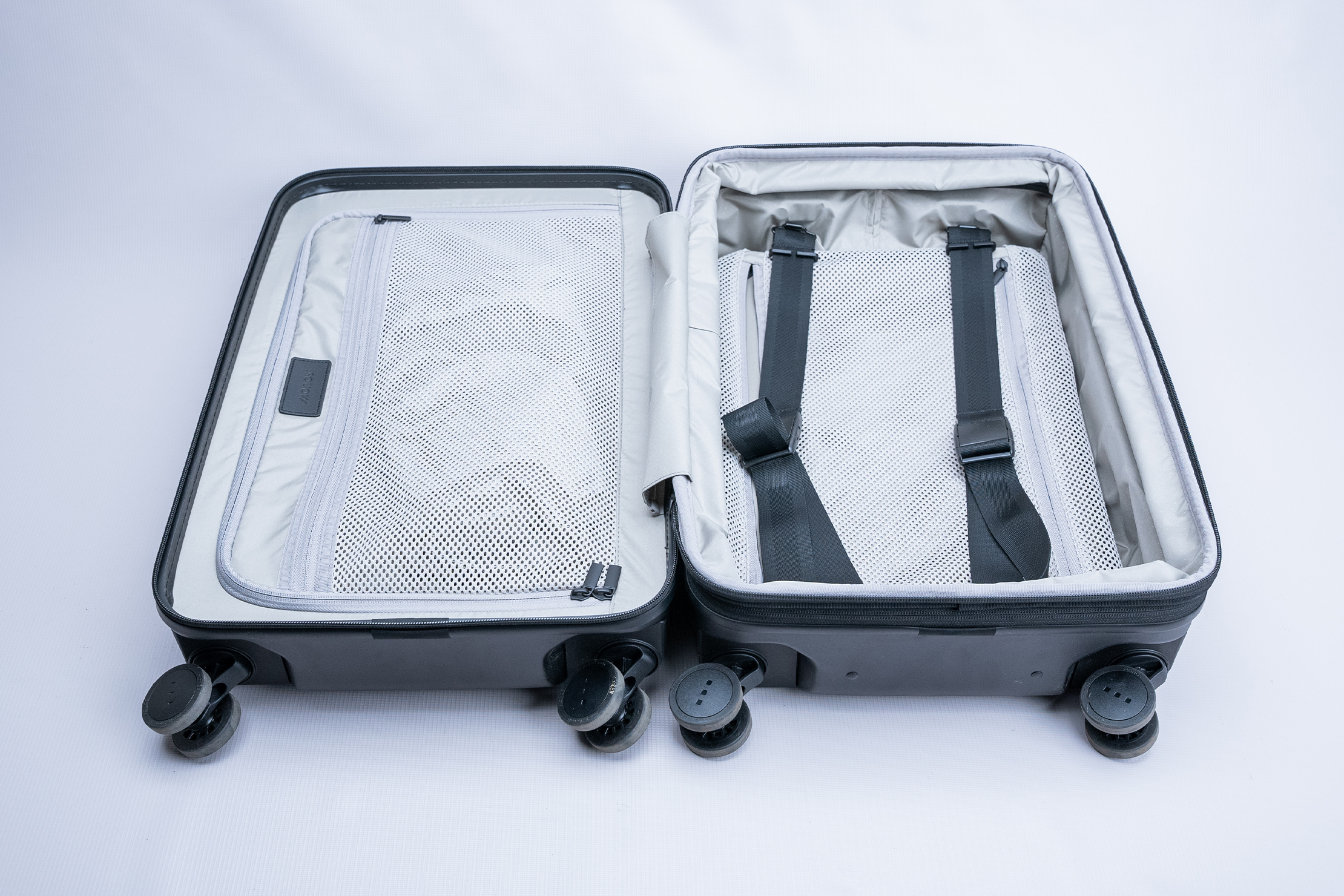
That said, since that whole front compartment occupies ga huge chunk of space, the left side mesh-covered compartment doesn’t have a ton of depth left usable. Other luggage with compartments like these can take about two layers of clothing, but we can only fit one layer in this one. This means the bulk of your packing will have to be on the main bucket space on the right, while this left side takes charge of storing accessories, such as a travel hair dryer, toiletry bag, winter gloves, buffs, and whatever extra gear you have that’s not too bulky. There’s also that wide mesh pocket on the cover you can use to store small items, by the way.
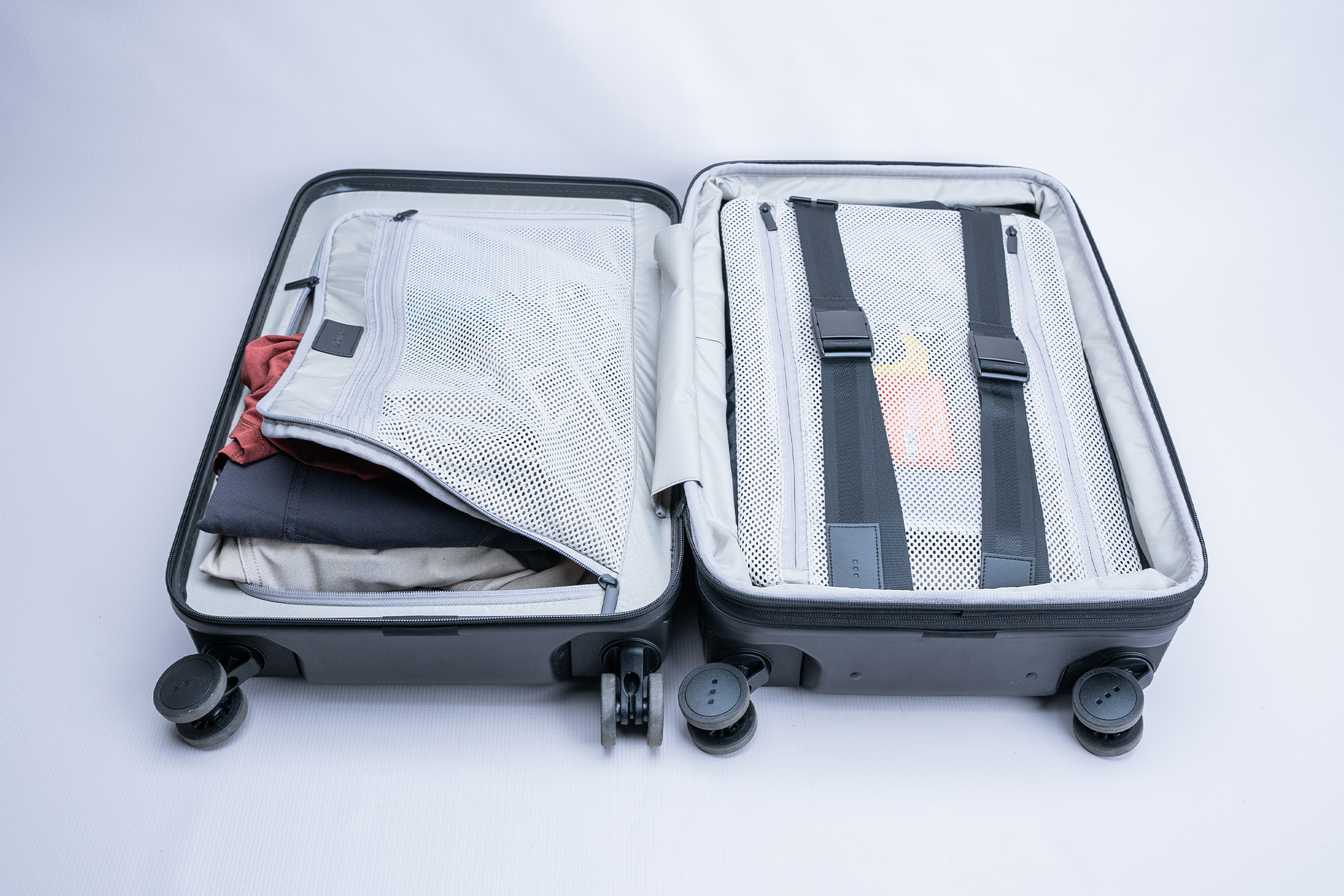
With the main bucket space serving as your main storage area, you can fit about two to five days’ worth of clothing. In our experience, you can squeeze five to seven days’ worth if you utilize the expansion system and use clever packing techniques such as using compression cubes and rolling your clothing. A compression panel held down by straps helps cinch that all down and includes a mesh pocket accessible through either side via zippers. You can put dress shirts in here to prevent them from being wrinkled or flat items like a packable hat.
Usage Timeline
Condition: Excellent
- Front compartment seems roomy compared to other luggage we’ve tested
- Digging the expansion system
- Has a sleek look even with the front pocket
Condition: Excellent
- Only a few scrapes here and there; otherwise, the shell is still in great shape
- Front compartment pocket cuts into left side of main compartment, so you’ve gotta pack smart
- Expanding the luggage helps a lot if you overpack, though it impacts carry-on compliance







Get your questions about the Monos Expandable Carry-On Pro answered from our team and the Pro Community right here on the page. Plus, join discussions with other members about gear, guides, and more.
Join Pack Hacker Pro or, Sign In